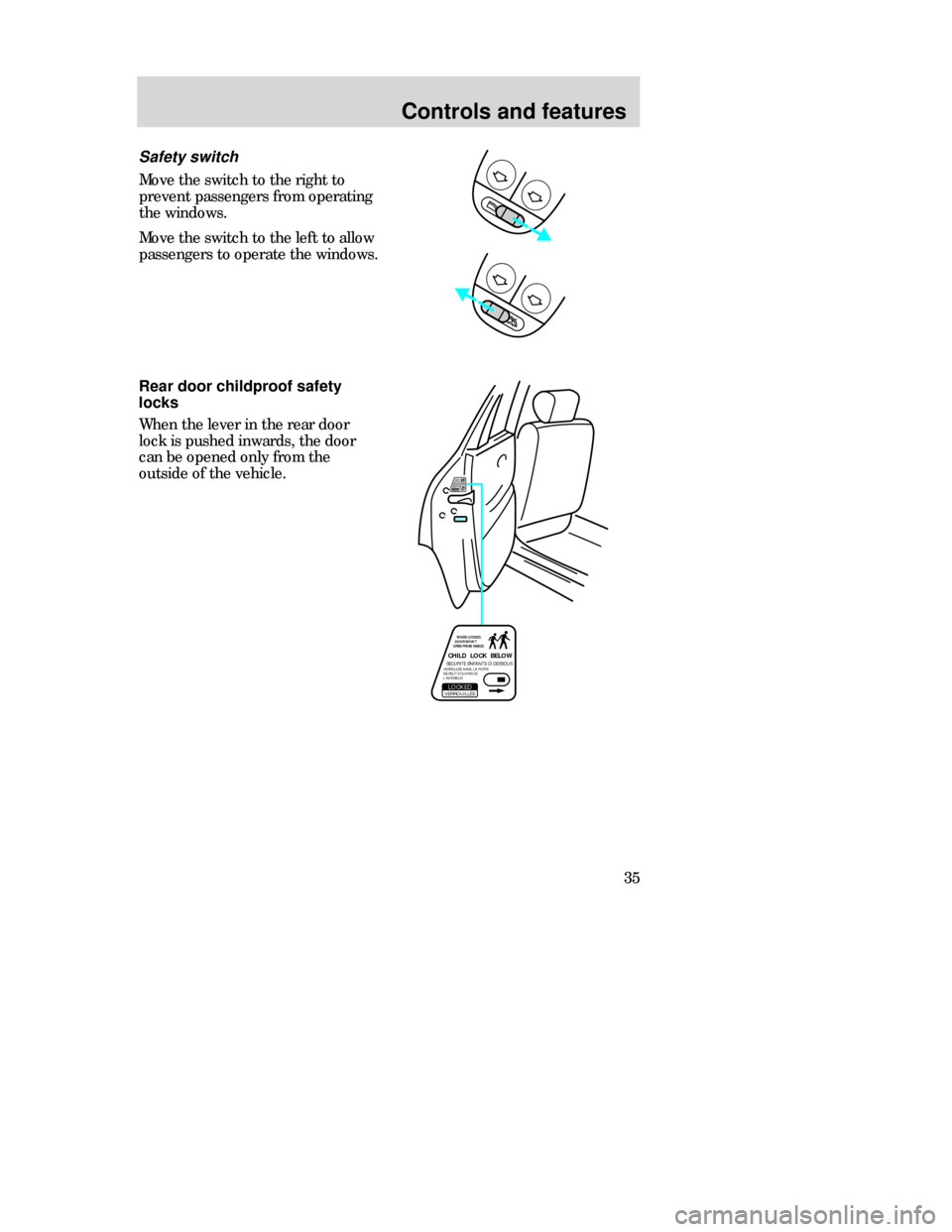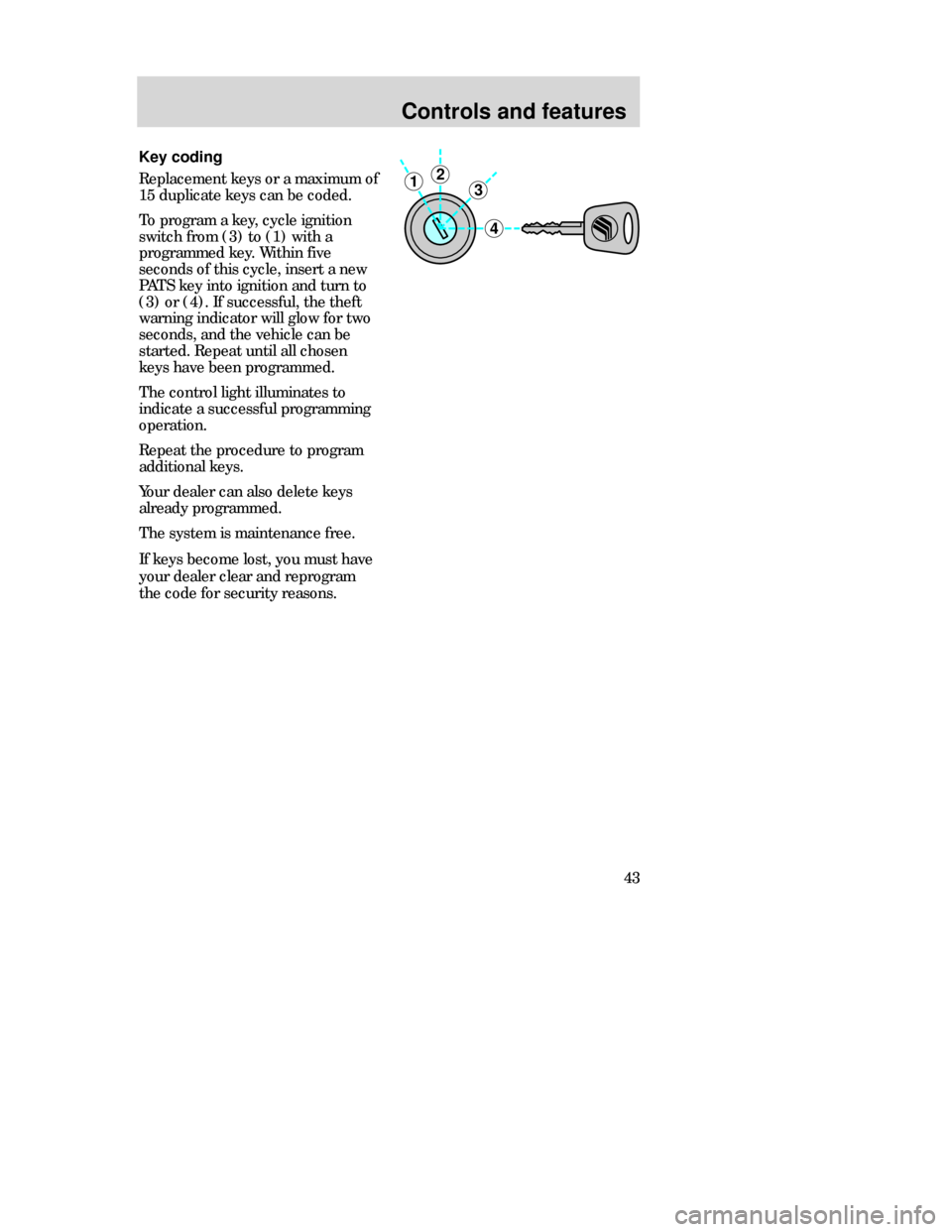ECU Mercury Mystique 1998 Owner's Manuals
[x] Cancel search | Manufacturer: MERCURY, Model Year: 1998, Model line: Mystique, Model: Mercury Mystique 1998Pages: 196, PDF Size: 1.65 MB
Page 25 of 196

Controls and features
25
POWERAUDIOAM/FM
SCAN
SEEK 312645ANSSIDE1-2EJECTVOLUME
MIRRORSDEF
LO
HIOFFPNL/FLR
PANEL
A/CFLOOR
FLR
DEF
MAX
A/C
000123
000010 20 3040506070
80
90
100
110
120
130MPH20 406055
80120 100
140
160
180
200EF 1
/
2UNLEADED FUEL ONLY
12
03x 1000
4
5
6
7
8
NORMALBRAKE
CHECK
ENGINE TRACTION
CONTROLO/D
OFF
:
I0 20
Off
Res
Set
AccCoast
On
Tilt steering
Pull the locking lever on the
steering column cover up to adjust
the steering column position.
Secure the wheel by pushing the
locking lever down.
Never adjust the steering
wheel while the vehicle is
moving.
CDW IIIC3Cont en MM 5/15/97 7:45 PM Page 25
Page 35 of 196

Controls and features
35
Safety switch
Move the switch to the right to
prevent passengers from operating
the windows.
Move the switch to the left to allow
passengers to operate the windows.
CHILD LOCK BELOWSECURITE ENFANTS CI-DESSOUS´VERROUILLEE,LOCKED WHEN LOCKED,
DOOR WON`T
OPEN FROM INSIDE.´VERROULEE AINSI, LA PORTE
NE PEUT S´OUVRIR DE
L´INTERIEUR.
CHILD LOCK BELOWSECURITE ENFANTS CI-DESSOUS´
VERROUILLEE,LOCKED
WHEN LOCKED,
DOOR WON`T
OPEN FROM INSIDE.
´VERROULEE AINSI, LA PORTE
NE PEUT S´OUVRIR DE
L´INTERIEUR.
Rear door childproof safety
locks
When the lever in the rear door
lock is pushed inwards, the door
can be opened only from the
outside of the vehicle.
CDW IIIC3Cont en MM 5/15/97 7:45 PM Page 35
Page 43 of 196

Controls and features
43 Key coding
Replacement keys or a maximum of
15duplicate keys can be coded.
To program a key, cycle ignition
switch from (3) to (1) with a
programmed key. Within five
seconds of this cycle, insert a new
PATS key into ignition and turn to
(3) or (4). If successful, the theft
warning indicator will glow for two
seconds, and the vehicle can be
started. Repeat until all chosen
keys have been programmed.
The control light illuminates to
indicate a successful programming
operation.
Repeat the procedure to program
additional keys.
Your dealer can also delete keys
already programmed.
The system is maintenance free.
If keys become lost, you must have
your dealer clear and reprogram
the code for security reasons.
3
4
21
CDW IIIC3Cont en MM 5/15/97 7:45 PM Page 43
Page 46 of 196

Seating and safety restraints
46
Folding rear seats (if equipped)
Pull the release knob located in the
luggage compartment. Fold down
the seat. The seatback cannot be
released while the built-in childseat
(if equipped) is open.
If you are carrying objects that
might damage the center rear
three-point safety belt, you can
unbuckle the end of the belt from
the small buckle on the seat
cushion and let the retractor reel it
up. Reconnect the belt tongue to
the buckle when you fold the seat
back up.
To raise the rear seatback, push the
seatback upward until it locks in
place. Make sure it is firmly latched
by pushing forward and back on it.
Check to see that the seat
and seatback are latched
securely in position. Keep luggage
area free of objects that would
prevent proper engagement.
CDW IIID Seat en MM 5/15/97 7:48 PM Page 46
Page 47 of 196

Seating and safety restraints
47
Important safety restraints
precautions
The use of safety belts helps to
restrain both driver and passenger
in case of a collision. In most states
and Canada, the law requires the
use of safety belts.
Always drive and ride with
your seatback upright and
the lap belt snug and low across
the hips.
Lock the doors of your
vehicle before driving to
lessen the risk of the door coming
open in a collision.
Cargo should always be
secured to prevent it from
shifting and causing damage to the
vehicle or harm to passengers.
To prevent the risk of injury,
make sure children sit where
they can be properly restrained.
SAFETYRESTRAINTS
Front and rear seat
occupants including
pregnant women, should wear
safety belts for optimum
protection in an accident.
CDW IIID Seat en MM 5/15/97 7:48 PM Page 47
Page 54 of 196

Seating and safety restraints
54Care of safety belts
Periodically check the belts for
damage or fraying. Check the
security of the anchorage points
and the locking action of the inertia
reels by giving each belt a sharp
tug.
Belts subjected to strain, as in the
result of an accident, should be
replaced and the anchorages
checked by your dealer or a
qualified technician.
Failure to follow these
instructions will affect the
performance of the safety belts
and increase the risk of personal
injury.
Safety belt warning label
A warning label has been placed on
the buckle of each of your vehicle’s
front seat safety belts.
In a collision of sufficient severity
while the safety belt is in use, the
safety belt buckle will pull out of
the sleeve so that all or part of the
orange portion of the lavel is
visible.
Whenever the orange
portion of the label is visible,
the safety belt must be replaced.
WARNING Replace buckle
assembly if this vehicle is in a collision
or if any orange portion of this label
is visible. (See Owner Guide). Failure
to replace this buckle assembly under
the above conditions could result in
severe personal injuries in the event
of collision.
AVERTISSEMENT Remplacer
l'ensemble de boucle de ceinture en
cas de collision avec ce véhicule, ou si
la partie orange de cette étiquette
est visible (Voir le Guide du
proprietare). Faute de remplacer cet
ensemble de boucle, des blessures
graves pourraient être encourues en
cas de collision.
REPLACE BUCKLE/REMPLACER BOUCLE
CDW IIID Seat en MM 5/15/97 7:48 PM Page 54
Page 65 of 196

Seating and safety restraints
65
Built-in child safety seat
(if equipped)
The rear seat may include a built-in
child seat. This child seat conforms
to all Federal and local motor
vehicle safety standards. Read the
labels located on the child seat
cushion and shoulder belt for
information on the built-in child
seat.
Use the built-in child seat only if
the child is at least one year old,
weighs 10-27 kg (22-60 lbs) and
the child’s shoulders fit below the
shoulder harness slots on the built-
in child seat.
Children not meeting these
requirements should be secured in
an aftermarket seat. Refer to Child
safety seatsin this chapter. Built-in child seat
All built-in child restraints,
including seats, buckles,
retractors, seat latches, interlocks,
and attaching hardware should be
inspected by a qualified dealer
technician after any collision.
CDW IIID Seat en MM 5/15/97 7:48 PM Page 65
Page 66 of 196

Seating and safety restraints
66
Built-in child seat retractors
The belts on built-in child seats are
equipped with a retractor. The
retractor will automatically snug
the belts around the child. If the
belts do not remain snug, take the
vehicle to your dealer or a qualified
technician for child seat repair. The
belts will not remain snug during a
collision if the retractor is not
functioning properly.
Child seat interlock safety
feature
The interlock ensures that a child
is not placed in the integrated child
seat when the folding seatback is
not securely latched.
It prevents the seatback from being
unlatched while the child seat is in
use. When the child seat is
deployed, the seatback cannot be
released.
CDW IIID Seat en MM 5/15/97 7:48 PM Page 66
Page 67 of 196

Seating and safety restraints
67
1. Make sure that the seatback is
securely latched in place.
2. Grasp the child seat cushion and
pull the top forward to release the
latch. Continue to unfold the child
seat until it rests on the seat in the
fully open position.
Placing your child in the built-in
child seat
Failure to follow all of the
instructions on the use of
this child restraint system can
result in your child striking the
vehicle’s interior during a sudden
stop or crash.
Never use the built-in child
seat as a booster cushion
with the adult safety belts. A child
using the adult belts could slide
forward and out from under the
safety belts.
The rear seatback must be
fully locked before operating
the child safety restraint system.
CDW IIID Seat en MM 5/15/97 7:48 PM Page 67
Page 71 of 196

Seating and safety restraints
71
Carefully follow all of the
manufacturer’s instructions
included with the safety seat you
put in your vehicle. If you do not
install and use the safety seat
properly, the child may be injured
in a sudden stop or collision.
Ford recommends the use of a
child safety seat having a top tether
strap. Install the child safety seat in
a seating position which is capable
of providing a tether anchorage.
For more information on top tether
straps see Attaching safety seats
with tether strapsin this chapter.
When installing a child safety seat:
•Use the correct safety belt buckle
for that seating postion.
•Make sure the tongue is securely
fastened in the buckle.
•Keep the buckle release button
pointing up and away from the
safety seat, with the tongue
between the child seat and the
release button, to prevent
accidental unbuckling.
•Put the safety belt in the
automatic locking mode. Refer to
Using automatic locking mode
in this chapter. Child safety seats
CDW IIID Seat en MM 5/15/97 7:48 PM Page 71